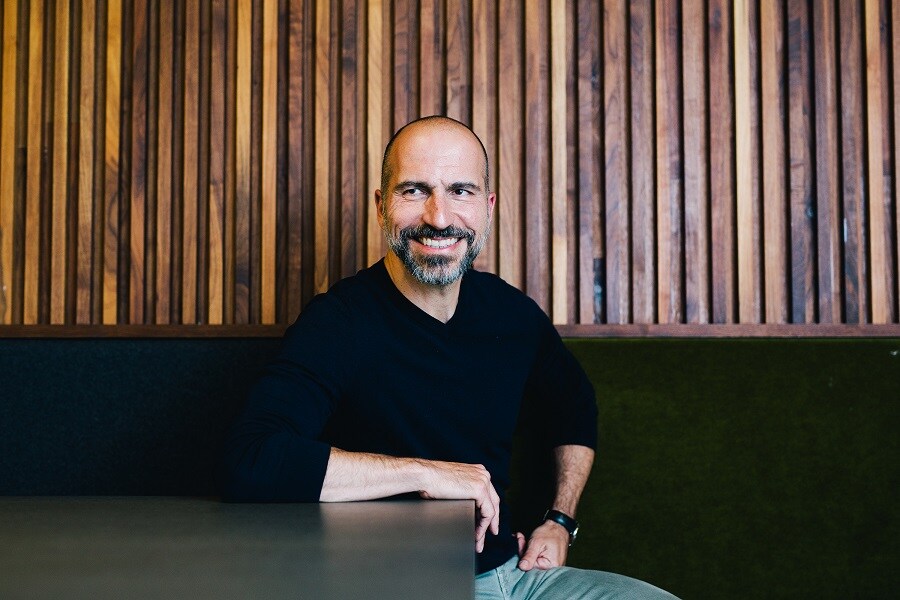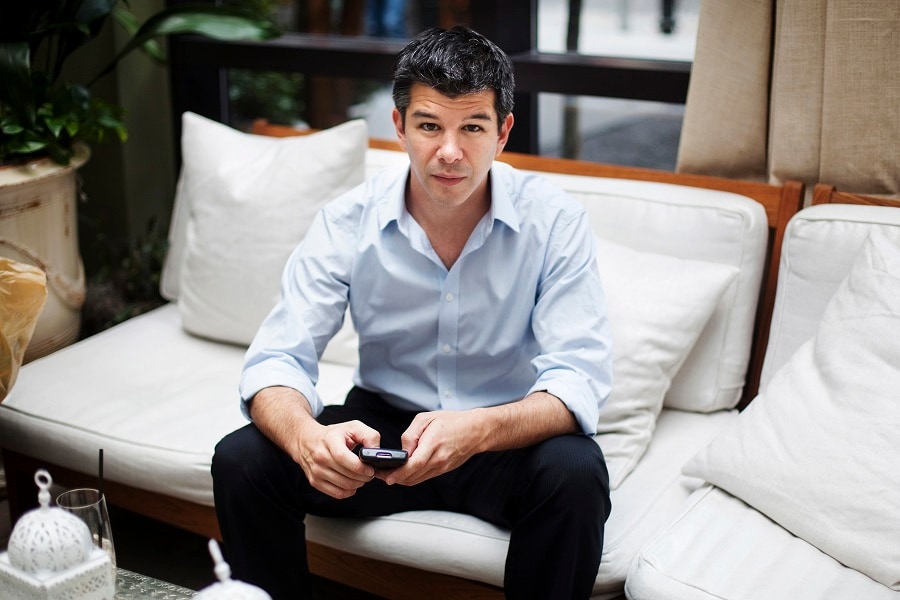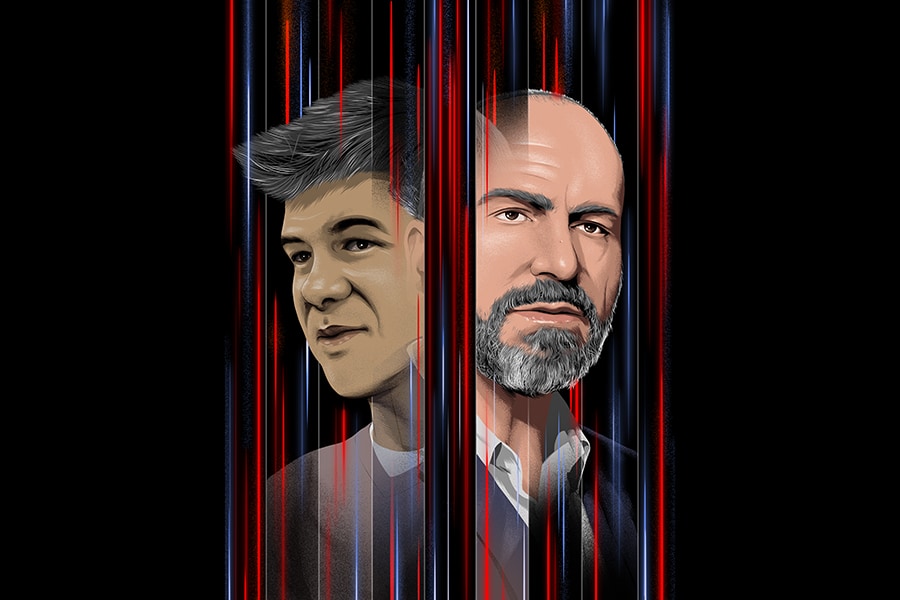Dara Khosrowshahi had a problem. His name was Travis Kalanick.
That, of course, was nothing new. When Khosrowshahi took over as chief executive of Uber in 2017, he became the best-compensated janitor in Silicon Valley, with a mandate to clean up the mess left by the company’s exiled founder. But this time, in mid-April, Khosrowshahi faced a Travis headache that lay in the future.
Uber was just weeks away from its initial public offering. After years of scandal, infighting and user revolt, this was supposed to be a $91 billion moment of triumph, when employees would become wealthy and the public could buy a piece of an indisputably world-changing company. The problem for Khosrowshahi, according to two people briefed on the matter, was that Kalanick wanted to be there.
As a former CEO and current board member, Kalanick had asked to take part in the hallowed New York Stock Exchange tradition of ringing the opening bell on May 10, the day Uber shares are slated to begin trading. He also wanted to bring his father, Donald Kalanick. It would be close to the second anniversary of the accidental death of Travis Kalanick’s mother, and of the dramatic boardroom coup that ousted him as boss. His presence on the exchange’s iconic balcony could make both Kalanick and the corporation appear resilient.
Khosrowshahi wasn’t having it. The original plan was to fill the rafters with Uber’s earliest employees and longest tenured drivers. Moreover, some people at the top of the company felt that Kalanick was still a toxic liability and that Uber should keep him at maximum distance as it tried to convince constituents that employees truly abided by a new motto: “Do the right thing. Period.” Kalanick’s appearance would unavoidably rekindle public memories of just how much of a disaster his final year was.
Besides, Khosrowshahi had bigger things to worry about than IPO pageantry. Uber is losing billions of dollars annually, and he needs to convince investors that it is a promising, long-term company — even if it won’t be turning a profit anytime soon. He didn’t need the distraction at Uber’s financial coming-out party. On Thursday evening, after The New York Times approached Uber for comment on this article, Khosrowshahi decided that Kalanick wasn’t welcome on the balcony, according to an Uber executive briefed on the plans.
The CEO wants to prove that the startup has evolved past Kalanick’s raucous, tech-bro culture — and his strategy of setting barrels of money aflame in the pursuit of growth above all else. But Uber’s past, to state the obvious about a company that is only a decade old, is simply not that far gone. Almost every instance of Kalanick’s bare-knuckled approach to capitalism illuminates something about Uber’s viability as a business today. (Citing the quiet period before an IPO, representatives for Uber, Khosrowshahi and Kalanick all declined to comment.)
The company has little good will with consumers or regulators in multiple jurisdictions. And Uber still loses money on nearly every fare, using venture capital to subsidize rides, invest in new areas and beat back a set of global competitors that offer an essentially identical service.
Kalanick’s heavy reliance on venture funding could be problematic for a public Uber in at least two ways. Arguably, it instilled habits of indiscipline, because executives could simply ask for more money whenever they wanted it, like rich kids with no cap on their allowance.
Second, and more troubling for retail investors, the bulk of investment returns might have already been realized. Uber acknowledged in a recent filing that its growth is slowing, fueling concern that venture firms, private equity shops, sovereign-wealth funds and other elite insiders have not left much upside for mom-and-pop investors.
The last big beneficiary of Uber’s private-market gains might have been SoftBank. The Japanese mega-conglomerate bought existing shares from Uber investors at a nadir, when the company was valued at roughly $42 billion. Just months later, as Uber recovered from its string of scandals, those shares had nearly doubled in value.
All IPOs are by nature unpredictable, but with Uber the possible outcomes seem especially extreme. Is it a juggernaut that, like Amazon before it, will someday flip the switch to profitability? Or is it something more like eBay, a well-known but puttering giant with its best growth long since behind it?
For now, Khosrowshahi’s job is to execute a drama-free public offering. He was able to use the chaotic events of Kalanick’s departure and his own hiring to secure a lucrative incentive. If he is able to attain a valuation of more than $120 billion for Uber over a period of 90 consecutive days, according to two people familiar with the matter and language included in Uber’s IPO prospectus, Khosrowshahi will personally net stock bonuses of more than $100 million.
 Dara Khosrowshahi, Uber’s chief executive, in San Francisco, Aug. 24, 2018.Image: Anastasiia Sapon/The New York Times
Dara Khosrowshahi, Uber’s chief executive, in San Francisco, Aug. 24, 2018.Image: Anastasiia Sapon/The New York Times
‘I really don’t know how you got this job’
Going public comes with additional scrutiny and financial reporting requirements — something Uber may have a tough time adjusting to. In the beginning, investors poured billions into the company while asking for little in return, trusting that the charismatic Kalanick knew what he was doing.
When the startup was founded in 2009, venture capitalists were looking everywhere to fund the next Larry Page of Google or Mark Zuckerberg of Facebook — the newest brilliant mind who might put a multibillion-dollar dent in the universe. Investors valued an entrepreneur’s zeal almost as much as the business plan he or she was selling. And nobody was more zealous than Kalanick.
In his mind, historians would one day mention Uber in the same breath as titans like Apple and Google, world-changing corporations that shaped the way billions of people used technology in their daily lives. Investors liked the idea of disrupting the taxi industry and public transportation, but they liked Kalanick even more. Despite a little salt and pepper in his hair — born in 1976, he was practically middle-aged for Silicon Valley — Kalanick was trim and boyish, with an excess of kinetic energy. When he was dangling a chance at Uber equity in front of VCs, he was a force of nature, combining the oracular skills of Steve Jobs with the aggression of Alec Baldwin’s salesman character in “Glengarry Glen Ross.”
Typically, startups go to venture firms’ offices to make their pitches. At its peak, Uber was in such demand that it flipped the power dynamic, making investors come to its San Francisco headquarters. Kalanick created a system based on scarcity. For one week, he would hold just three meetings per day with potential backers, forcing them to compete for slots. (He called the method the “homeshow,” in contrast with the traveling “roadshow” that pre-IPO companies conduct.)
Venture capitalists didn’t care that Uber was awash in red ink, as long as the user numbers kept climbing. By the end of 2016, Uber was valued at nearly $70 billion. But abruptly, by the middle of 2017, investors started to worry in earnest that their stakes were in jeopardy of shrinking to zero. A pileup of scandals among Uber employees — from sexual harassment charges to systematically evading law enforcement — all seemed to reflect Kalanick’s personality and disregard for outsiders, and they cast his business choices in a new light.
Uber’s billions in losses could be interpreted as savvy investments, keeping competitors at bay in what would evolve into a winner-take-all market. Or they could be the heedless spending of someone who cared more about winning in the moment than building a long-term company.
One way Uber got to a position of dominance in cities was by throwing incentives at drivers and lowering barriers to entry — so low that people who might have been prevented from driving in the official taxi industry could easily work for Uber. That included predators. Over time, the company received such a volume of sexual misconduct allegations that to keep track of them, it had to create its own taxonomy of 21 different kinds of misbehavior and assault. (The taxonomy was developed and made public in an “open source” approach, a move the company has said is an effort to improve safety across the ride-hailing industry.)
All of a sudden, Uber’s sense of ubiquity and inevitability seemed to be much less of a sure thing. Over a whirlwind weekend in August 2017, Khosrowshahi was elected to replace Kalanick as CEO. He was a relative outsider to the Bay Area — Expedia, the company he’d been running, was based in Seattle — and he was not a household name. But he had a good reputation, a warm appearance and, to some, one more big advantage: He wasn’t Travis Kalanick.
In the fall of 2017, not long after Khosrowshahi started his new job, six of Uber’s board members received calls from Barry Diller, the chairman and senior executive of InterActive Corp. and a longtime mentor of Khosrowshahi. Diller was being protective of his protégé and wanted to know how, exactly, he had secured one of the most formidable CEO positions in all of tech.
Later, Diller called Khosrowshahi with his findings: He’d been elected almost accidentally, the result of warring factions on the board vying for two different candidates and finally settling on a third. That ended up being Khosrowshahi. “I really don’t know how you got this job,” Diller told Khosrowshahi, describing the level of chaos and utter dysfunction at the very top of Uber. “No one even voted for you.”
 Travis Kalanick then the chief executive of the ride-hailing service Uber, in New York, May 2, 2011. Image: Julie Glassberg/The New York Times
Travis Kalanick then the chief executive of the ride-hailing service Uber, in New York, May 2, 2011. Image: Julie Glassberg/The New York Times
The Dekalanickization of Uber
Some 20 months later, many of Uber’s most important stakeholders consider Khosrowshahi’s appointment a stroke of luck.
After parachuting into a profoundly fractured board, the CEO has managed to make a kind of peace among the company’s directors, a group that includes Kalanick. Leaks about internal issues have largely stopped flowing to the press. Backbiting among executives has subsided. And Khosrowshahi has refrained from extravagances like booking Beyoncé to perform at private company functions, as Kalanick did in 2015, at a cost of $6 million in restricted stock units.
Khosrowshahi’s admirers say the calm is a result of his long experience with corporate distress. After years of running InterActive Corp.’s mergers, acquisitions and finance divisions, Khosrowshahi was tapped to lead Expedia as chief executive in 2012 — a time of intense political drama inside the online travel company. Khosrowshahi stabilized some of the internal tumult, according to Neha Parikh, the president of Hotwire, who worked alongside Khosrowshahi at the time. “No matter who you are,” she said, “Dara makes you feel heard.”
(From May 2015 until September 2017, Khosrowshahi was on The New York Times board.)
At Uber, Khosrowshahi hired a slew of lawyers to plumb and correct years of the company’s legal deficiencies. He also edited Kalanick’s list of 14 cultural values. Ranging from “Always Be Hustlin’” to “Super Pumped,” they read like Amazon’s leadership principles run through a bro-speak translation engine; now they have been made into a blander set of eight platitudes. (Among them: “We persevere.”) Investors who had billions riding on Uber’s success have been happy to see a constant stream of negative headlines shrink to a trickle.
While Khosrowshahi has seemed to successfully reform many of Uber’s cultural issues, skeptics note that the company’s business fundamentals remain much the same. Uber lost nearly $2 billion in 2018, the first full year under Khosrowshahi’s leadership. That comes even after a retreat from a number of costly battles with ride-hailing competitors in China, Russia and Southeast Asia.
On Uber’s roadshow to pitch itself to institutional investors (there’s no “homeshow” this time around), Khosrowshahi has broken with Kalanick’s worldview that Uber is competing in a winner-take-all market. Ride-sharing will be a “winner-take-most” game, as Khosrowshahi puts it, according to people familiar with his presentation.
He has also embraced the idea that his company is like Amazon — a logistics giant in the making. His pitch casts Uber’s sustained losses as both an attempt to defend its existing market share from competitors while simultaneously investing in Uber’s future growth.
That story seeks to frame Uber as a technology “platform.” Ride-hailing, the thinking goes, is a mere jumping-off point for other markets, like bikes and scooters, food delivery, long-haul trucking — even flying cars. “Just like Amazon sells third-party goods, we are going to also offer third-party transportation services,” Khosrowshahi said in an interview last year.
Still, Uber has no clear path to turning a profit in the next few years, and the risks section of its registration statement runs to 48 pages, out of 285 total. Shares of Lyft, its nearest competitor, have fallen some 26 percent since their March debut.
Uber’s bankers seem to have internalized the doubts. After initially targeting an IPO opening range of roughly $48 to $55 per share, Uber reduced expectations to roughly $44 to $50 per share at a valuation of $80 billion to $91 billion — significantly lower than the $90 billion to $100 billion range it originally sought.
Despite all Khosrowshahi has done to distance Uber from its founder, Kalanick remains intimately connected to the company he built. He remains on Uber’s board, and Khosrowshahi has shown no signs of agitating for a shake-up of the group in the months following an IPO, as some had expected he would.
Friends of Kalanick say that he feels unfairly targeted by Uber’s IPO paperwork and its implicit criticisms of his leadership. And every time Khosrowshahi uses the word “culture,” Kalanick considers it a thinly veiled synonym for his reign, according to people familiar with his thinking. They add that Kalanick hopes that his successor will use the IPO to bury the hatchet between the two men and mark a new chapter in Uber’s history. Even former enemies on the board, like Matt Cohler of Benchmark, have spoken in favor of Kalanick’s involvement, according to a report from Axios.
No matter where he stands when Uber shares begin to trade — Kalanick could watch from the stock exchange floor, or skip the event entirely — he will have the consolation of making on paper several billion dollars. That is 600 times what Khosrowshahi’s stake will be worth. Not that he’s one to let that bother him.
“He’s like Teflon. You can’t scratch him,” said Avid Larizadeh Duggan, Khosrowshahi’s cousin and the chief operating officer of Kobalt, a music startup. “But it’s a positive way, not robotic. That’s why he’s such a good choice for this role, because you have to be — especially from where he started.”


 Dara Khosrowshahi, Uber’s chief executive, in San Francisco, Aug. 24, 2018.
Dara Khosrowshahi, Uber’s chief executive, in San Francisco, Aug. 24, 2018. Travis Kalanick then the chief executive of the ride-hailing service Uber, in New York, May 2, 2011.
Travis Kalanick then the chief executive of the ride-hailing service Uber, in New York, May 2, 2011. 



